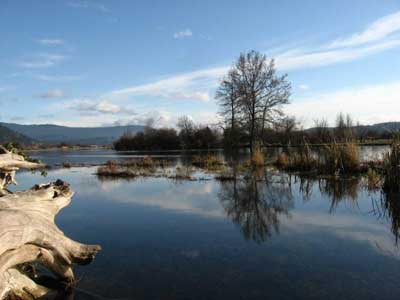Marvelous Marshes
The Marvelous Marshes Project was a two year wetland education and restoration project that aimed to increase public awareness of the importance of wetland ecosystems while engaging participants in on the ground restoration activities to improve the ecological integrity of wetlands. Activities included quarterly workshops, restoration work parties and environmental education projects with youth. These activities help improve habitat for wildlife, improve water quality and provide meaningful opportunities for the community to be involved in local stewardship. Wetlands are among the most productive ecosystems in the world and support an immense variety of species from plants and animals to microbes and insects (US EPA, 2012.) The Marvelous Marshes Project provided necessary support to landowners and community members working to protect and restore wetland habitats within the Cowichan Watershed. It also provided educational opportunities for youth and members of the public on the benefits of wetlands and their stewardship. Restored wetlands provides many benefits to wildlife by increasing habitat for invertebrates, amphibians, birds and fish. Small wetland habitats are becoming increasingly rare in our landscapes but they are critical habitats for many macroinvertebrate and amphibian species. Urban development continues to occur in our region and is threatening the uniqueness and biodiversity within our watershed. Our desire to be close to nature has led to encroachment into wetland habitats. Damage to these important habitats has accelerated in recent years and is now at a critical stage. Much of this could be attributed to landowners simply lacking basic knowledge or understanding of the wetland ecosystem and its functions, how their actions affect these functions and how some simple changes can make a significant difference. Approximately 90% of the Cowichan Watershed is privately owned making private land stewardship essential for its conservation. “It is difficult for people to fully value what they don\’t understand. To protect and enhance the Cowichan watershed and its resources (including wetlands) it is important that those who live in the watershed develop a good understanding of the watershed, watershed resources as well as activities that are carried out to protect and enhance the watershed,”(Cowichan Watershed Board, 2011). When people understand how their actions affect the environment they are likely to become engaged in its protection, and seek information on how to mitigate these effects. The functions of a wetland and the values of these functions to human society depend on a complex set of relationships between the wetland and the other ecosystems in the watershed (US EPA, 2012). The Marvelous Marshes Project provides a necessary service for community members needing resources, training, education, referrals and leadership in order to increase the effectiveness of their environmental stewardship activities and goals to preserve these functions. By partnering with other community stewardship groups, we work together to ensure the information reaches communities throughout the Valley and that landowners interested in restoring or improving their wetlands receive the support they require. What were the goals and objectives for this project? Goal 1 – To increase the knowledge of residents in the conservation, protection, and stewardship of wetlands. Objectives:- Hold quarterly workshops on topics that pertain to wetland stewardship such as wetlandkeepers, wetland mapping, naturescaping, natural pest control, plant and wildlife monitoring and habitat restoration techniques.
- Create an information packages for land owners with information about wetland stewardship.
- Educate and engage youth through 10 environmental programs and projects.
- Restore wetland areas to provide important habitat for fish, amphibians, wildlife and plants and ecosystem services to adjacent lands.
- Encourage the protection of wetlands as important filters of storm water run-off and carbon sinks.
- These objectives will be measured first by establishing baseline data for the selected wetlands using Wetlandkeepers methodology and then re-assessing them through survey monitoring after restoration activities have taken place.
- Foster community volunteerism and stewardship by involving at least 100 volunteer participants in the restoration of wetlands while instilling a sense of value and ownership.
- Through at least 6 restoration work parties we will engage the community to take action on the ground to improve wetland habitat.

